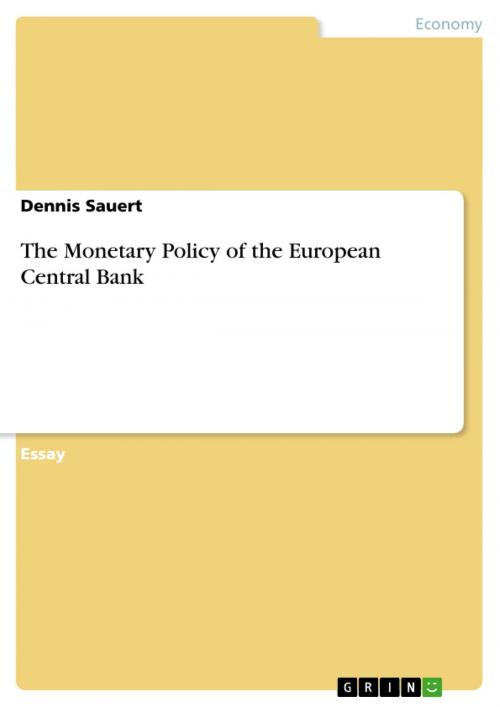The Monetary Policy of the European Central Bank
Nonfiction, Social & Cultural Studies, Political Science, Politics, Economic Policy| Author: | Dennis Sauert | ISBN: | 9783640486359 |
| Publisher: | GRIN Publishing | Publication: | December 4, 2009 |
| Imprint: | GRIN Publishing | Language: | English |
| Author: | Dennis Sauert |
| ISBN: | 9783640486359 |
| Publisher: | GRIN Publishing |
| Publication: | December 4, 2009 |
| Imprint: | GRIN Publishing |
| Language: | English |
Essay from the year 2009 in the subject Business economics - Economic Policy, grade: 1,7, Berlin School of Economics and Law, language: English, abstract: The national currency of each country in Europe was an indispensable element of national sovereignty and bank notes as an expression of national culture and trademark. With successive significance of bank notes as a means of payment in modern economic life central banks gradually gained a stronger role and monetary policy has become an integrated part of economic policy. In respect to this development the implementation of stage three of the EMU in 1999 was an important caesura in European history since a major part of European political independent countries gave up their sovereignty of monetary policy by adopting and agreeing on an irrevocable peg of their domestic currency to the Euro. This required a change to a new European monetary policy in the sector of European central banking. Thus, the ECB was founded and the NCB's of the MS integrated into a European central bank system. It has never been achieved a similar integration process of a policy area in the EU as that of the common monetary and exchange rate policy. The EU has nowhere else been more authentically developed in its identity than in the area of the Euro and the ECB. Nowadays, the participating MS form a currency area that is considered as the second largest economic area behind the USA. This reveals the worldwide significance of European monetary policy that will be explained in the following. The first chapter will briefly comment on the institutional framework structure before the topic of price stability will be introduced. Chapter four and five will examine the transmission process and the monetary strategy of the ECB. In the sixth chapter monetary instruments will be closely described while chapter seven explains the use of instruments of the ECB to react to the current financial crisis. Concluding, a short assessment of European monetary policy will then frame the end of this paper.
Essay from the year 2009 in the subject Business economics - Economic Policy, grade: 1,7, Berlin School of Economics and Law, language: English, abstract: The national currency of each country in Europe was an indispensable element of national sovereignty and bank notes as an expression of national culture and trademark. With successive significance of bank notes as a means of payment in modern economic life central banks gradually gained a stronger role and monetary policy has become an integrated part of economic policy. In respect to this development the implementation of stage three of the EMU in 1999 was an important caesura in European history since a major part of European political independent countries gave up their sovereignty of monetary policy by adopting and agreeing on an irrevocable peg of their domestic currency to the Euro. This required a change to a new European monetary policy in the sector of European central banking. Thus, the ECB was founded and the NCB's of the MS integrated into a European central bank system. It has never been achieved a similar integration process of a policy area in the EU as that of the common monetary and exchange rate policy. The EU has nowhere else been more authentically developed in its identity than in the area of the Euro and the ECB. Nowadays, the participating MS form a currency area that is considered as the second largest economic area behind the USA. This reveals the worldwide significance of European monetary policy that will be explained in the following. The first chapter will briefly comment on the institutional framework structure before the topic of price stability will be introduced. Chapter four and five will examine the transmission process and the monetary strategy of the ECB. In the sixth chapter monetary instruments will be closely described while chapter seven explains the use of instruments of the ECB to react to the current financial crisis. Concluding, a short assessment of European monetary policy will then frame the end of this paper.















